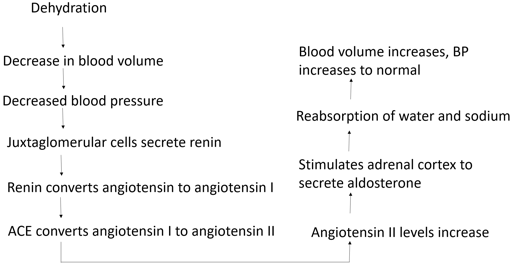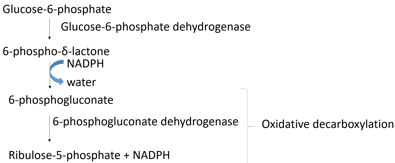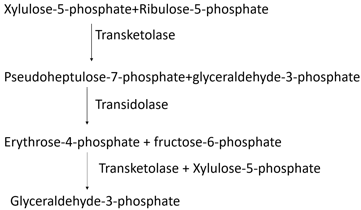This set of Enzyme Technology Questions and Answers for Campus interviews focuses on “Clinical Significance of Angiotensin Converting Enzyme and Glucose-6-phosphate Dehydrogenase”.
1. _________ is a group of a hormone of the adrenal cortex that maintains ion balance.
a) Acetylcholine esterase
b) Creatine kinase
c) 5I – nucleotidase
d) Angiotensin converting enzyme
View Answer
Explanation: Angiotensin converting enzyme is a group of a hormone of the adrenal cortex that maintains ion balance. Acetylcholine esterase converts acetylcholine to choline and acetate. Creatine kinase converts creatine phosphate to creatine and ATP. 5I – nucleotidase degrade purine nucleotides by a pathway in which they lose the phosphate group.
2. Which of the following is not a clinical application of angiotensin converting enzyme?
a) Regulates blood pressure
b) Regulates blood volume
c) Gout
d) Prevents acidosis
View Answer
Explanation: Gout is disease of joints caused by elevated concentration of uric acid in blood. Joints become inflammed, painful and arthritic due to the abnormal deposition of uric acid crystals. Clinical application of angiotensin converting enzyme are:
• It regulates the sodium and potassium ions and helps adjusts blood pressure and blood volume.
• Aldosterone promotes excretion of hydrogen ions in the urine. This removal of acids from the body can help to prevent acidosis.
3. Which pathway is represented in the following diagram?

a) Purine degradation pathway
b) Glycolysis
c) Renin angiotensin aldosterone pathway
d) TCA cycle
View Answer
Explanation: The pathway represented in the above diagram is renin angiotensin aldosterone pathway. The initial stimuli for this pathway is dehydration which leads to decrease in blood volume and blood pressure. This stimulates the juxtaglomerular cells secrete renin which converts angiotensin to angiotensin I. ACE converts to angiotensin I to angiotensin II. Thus increases its level. This increase stimulates adrenal cortex to secrete aldosterone. This leads to reabsorption of water and sodium which increase blood volume and BP raises to normal.
4. Glucose-6-phosphate dehydrogenase occurs in _________
a) adipose tissue
b) saliva juice
c) pancreatic juice
d) tears
View Answer
Explanation: Glucose-6-phosphate dehydrogenase occurs in liver adipose tissue etc. α – amylase is seen in higher concentrations in pancreatic and saliva juice, whereas in lower concentrations in tears, urine, milk fallopian tubes, etc.
5. What reaction is represented in the diagram?

a) Purine degradation pathway
b) Oxidative step of pentose phosphate pathway
c) Glycolysis
d) TCA cycle
View Answer
Explanation: Pentose phosphate pathway has two steps: oxidative and non-oxidative. Oxidative step is represented in the following diagram. Glucose-6-phosphate is converted to 6-phosphoglucono-δ-lactone by glucose-6-phosphate dehydrogenase. This is converted to 6-phosphogluconate which is then converted to ribulose-5-phosphate by 6-phosphogluconate dehydrogenase. This is called oxidative decarboxylation.
6. Which step of pentose phosphate pathway in represented in the following diagram?

a) Oxidative step
b) Renin conversion step
c) Non-oxidative step
d) Angiotensin conversion step
View Answer
Explanation: Non-oxidative step of pentose phosphate pathway is represented in the above diagram. Ribulose-5-phosphate from oxidative step and xylulose-5-phosphate react with each other in presence of transketolase to produce pseudoheptulose-7-phosphate and glyceraldehye-3-phosphate. This is converted erythrose-4-phosphate and fructose-6-phosphate by transidolase enzyme. In the presence of transketolase and reaction with xylulose-5-phosphate, glyceraldehyde-3-phosphate.
7. Defect in glucose-6-phosphate dehydrogenase leads to ________
a) red cell hemolysis
b) diagnosis of organophosphate poisoning
c) salivary gland disorders
d) ruptured ectopic pregnancy
View Answer
Explanation: Defect in glucose-6-phosphate dehydrogenase leads to red cell hemolysis. Diagnosis of organophosphate poisoning is a clinical application of pseudocholine esterase. Following clinical condition shows an increase of amylase concentration:
• Salivary gland disorders such as mumps, salivary calculi.
• Ruptured ectopic pregnancy.
Sanfoundry Global Education & Learning Series – Enzyme Technology.
To practice all areas of Enzyme Technology for Campus Interviews, here is complete set of 1000+ Multiple Choice Questions and Answers.
If you find a mistake in question / option / answer, kindly take a screenshot and email to [email protected]
- Practice Biotechnology MCQs
- Apply for Chemical Engineering Internship
- Apply for Biotechnology Internship
- Check Enzyme Technology Books
- Check Biotechnology Books
